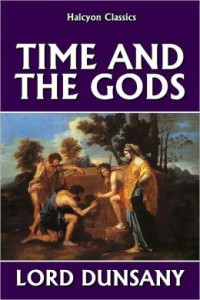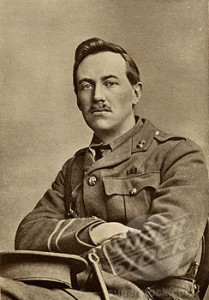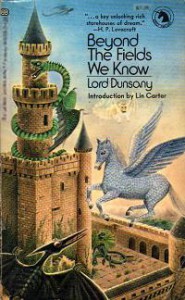Lord Dunsany Re-Read: Time and the Gods Part 1
 Bill Ward and I are continuing our Lord Dunsany re-read, starting with the first two stories published in the original Time and the Gods (not the omnibus). You can find a free copy of the book here and join in the discussion. Our rating system is pretty simple. One star is a standout, and two stars is truly notable. Most of Lord Dunsany’s fantasy work is already fairly remarkable, so even a “no star” story on this scale may be worth a look.
Bill Ward and I are continuing our Lord Dunsany re-read, starting with the first two stories published in the original Time and the Gods (not the omnibus). You can find a free copy of the book here and join in the discussion. Our rating system is pretty simple. One star is a standout, and two stars is truly notable. Most of Lord Dunsany’s fantasy work is already fairly remarkable, so even a “no star” story on this scale may be worth a look.
 Howard: Time and the Gods is what really turned me on to the power of Lord Dunsany. I’d read a tale or two in other collections and found them interesting, but I tried reading his first volume of short stories with only a little success. I didn’t become a convert until I dipped into Time and the Gods. It’s more quintessentially “Dunsanian.” It’s less self-conscious than the latter work and more approachable than the earlier. Here he seems overcome with inspiration and excitement about creating these wonderful cycles of mythology from whole cloth.
Howard: Time and the Gods is what really turned me on to the power of Lord Dunsany. I’d read a tale or two in other collections and found them interesting, but I tried reading his first volume of short stories with only a little success. I didn’t become a convert until I dipped into Time and the Gods. It’s more quintessentially “Dunsanian.” It’s less self-conscious than the latter work and more approachable than the earlier. Here he seems overcome with inspiration and excitement about creating these wonderful cycles of mythology from whole cloth.
Bill: I agree. These are the sorts of stories I always associated with Dunsany.
“Time and the Gods:” Both of these stories (perhaps the entire collection?) are told in the mythic tradition, with Dunsany writing in the poetic and antique style I most associate with his work. The great themes are there from the word “go” as well as fabulous forbidden cities, and the vast ever-changing expanse of eons of time. Here Time is the “swarthy servant” of the gods, who dispatch him on missions to smite or heal while remaining aloof in their immortal marble city of Sardathrion. But it seems even the gods and their city are not immune to Time, who will call no one master for long. Effective mythic-style personification, but I thought the story was a bit too much in the style-over-substance camp (especially when contrasted with the following tale!), with the lamenting of the gods in dialog not really delivering the emotional punch that a better narrative climax could have. Top marks for a sword-armed, bloody-handed Time overthrowing Sardathrion, symbols of such intimate and immediate violence are not what I expected in an anthropomorphized time, where something like an old, patient, bearded man with an hourglass would seem the cliche norm.
 Howard: That’s an excellent point. On re-reading this I found myself nodding and thinking, yes, this is good Dunsany, but it’s not yet great, and here are the familiar themes, Time, for instance, ready to cull all that we hold dear, and the fall of a beloved city. But I’d forgotten what you say here — the inventive handling of Time as an entity that even the gods learn to fear. I wonder if anyone else had ever written anything quite like this? I don’t recall seeing Time turn up in any similar way in the works of Dunsany’s few predecessors.
Howard: That’s an excellent point. On re-reading this I found myself nodding and thinking, yes, this is good Dunsany, but it’s not yet great, and here are the familiar themes, Time, for instance, ready to cull all that we hold dear, and the fall of a beloved city. But I’d forgotten what you say here — the inventive handling of Time as an entity that even the gods learn to fear. I wonder if anyone else had ever written anything quite like this? I don’t recall seeing Time turn up in any similar way in the works of Dunsany’s few predecessors.
Still and all, I’m not starring this one. It’s Dunsany, which makes it remarkable enough. But there are far more remarkable works in his canon.
Bill: “The Coming of the Sea:” ** It’s hard not to think of the rugged Irish coastline of Dunsany’s home while reading this, and his language certainly rises to the occasion in describing a war between the sea and the land. Slid, a new god, the personified sea, “gleaming azure and fair with a thousand smiles, and swayed with a thousand moods,” appears on earth one day and starts conquering the land of the gods “inch by inch and mile by mile.” The four winds are sent against him, but cannot stop him.The rivers of the world are seduced by Slid’s sighing song and flow out to meet him — the channels they carve in the hills and cliffs of the land are breeches in the gods’ defenses. Finally it is only Tintaggon (perfect name), mightiest of mountains, that can stand against Slid, standing firm even against the combined might of five oceans. The victory preserves the green valleys of the gods, but only in a perpetual stalemate between mountain and sea, with a future as yet unknown. This story has everything working in balance, and is a wonderful example of taking the tools and metaphor of myth and combining it with a modern narrative approach. Two stars.
Howard: Well said. This is a majestic, mythic story. Once I read this for the first time I knew I was on to something really fabulous. Jack Vance and Dunsany are worlds apart, but they share this — they can toss off dozens of fascinating ideas or incidental descriptors almost with contemptuous ease. You can imagine other artists scrambling after these scraps to gather them before they float away so that they can explore them more fully. Vance and Dunsany also are alike in their sheer ability to invent from whole cloth places and moments and, on Dunsany’s part, stories that feel like true myths we just never heard before.
Did I mention I love this little tale? Two stars from me as well.
Hope you’ll join us next week for the next two stories, “A Legend of the Dawn” and “The Vengeance of Men.”
2 Comments